You'll spot plant sunburn first on the uppermost leaves exposed to direct light. Initially, the affected areas turn yellow or white as chlorophyll breaks down, similar to human skin peeling after a bad burn. As damage progresses, you'll notice brown, crispy edges developing across leaf surfaces. When more than half the leaf shows these symptoms, it'll start withering and drying out. Understanding the early warning signs helps you protect your plants before permanent damage occurs.
Identifying Telltale Signs of Plant Leaf Scorching
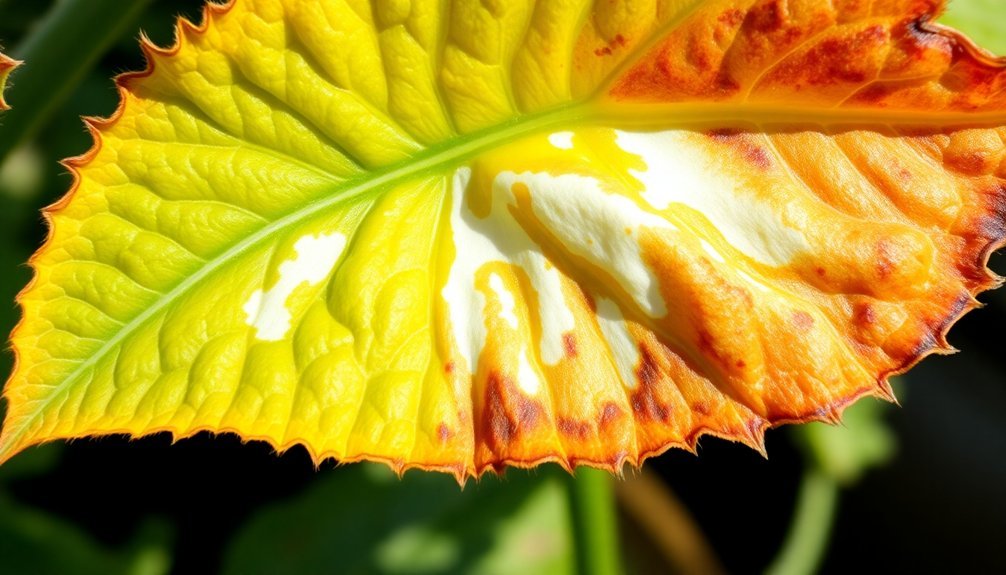
When your plants show signs of sunburn, the damage typically appears first on the uppermost leaves exposed to direct sunlight. You'll notice these sunburned plant leaves turning yellow or white, indicating the initial stages of sun damage.
If the exposure continues, the affected foliage will develop brown, crispy edges that can quickly spread across the entire leaf surface.
Watch for signs of withering and dryness, particularly when half or more of a leaf becomes scorched. These symptoms can emerge within hours of excessive sun exposure, so it's essential to monitor your plants regularly.
While other issues like overwatering can cause discoloration, sunburn is distinct because it primarily affects the top leaves. When you spot yellowing or browning concentrated at the plant's crown, you're likely dealing with sun damage.
Common Symptoms of Indoor Plant Sun Damage
Indoor plants can suffer severe sunburn when moved abruptly to brighter locations or exposed to intense afternoon rays.
You'll notice the first signs of damage on the uppermost leaves, which take the direct hit from excessive sunlight. These affected leaves will show distinct yellowing or whitening, while the lower, shaded foliage often remains healthy.
Watch for brown, crispy edges on the leaves, as this indicates advanced sunburn damage. If you see these symptoms, you'll need to act quickly since sunburn can develop in just a few hours of intense exposure.
When leaves become more than 50% scorched, they won't recover their natural color. It's best to remove these heavily damaged leaves to help your plant redirect energy to healthy growth and recovery.
Early Warning Signs Your Plant Is Getting Too Much Light
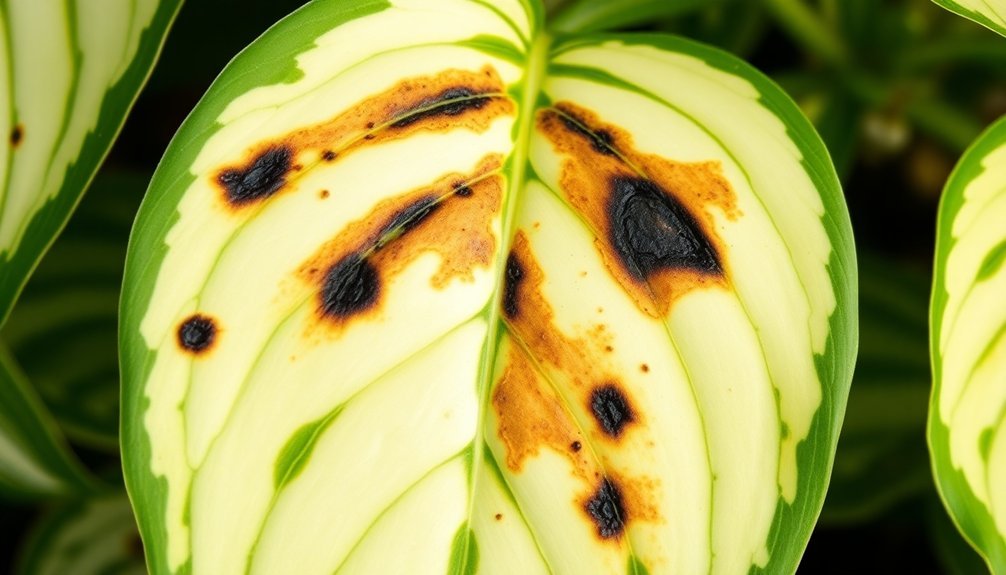
Before your plant develops severe sunburn damage, subtle warning signs will alert you to excessive light exposure. The most noticeable early indicator is when leaves turn yellow or white, particularly on the top portion of your plant where sunlight hits directly. You'll notice these changes within just a few hours of overexposure.
While your plant's lower leaves might still look healthy and green, don't let this fool you. Watch for leaf edges becoming dry and crispy, as this signals that sunburn damage is becoming more severe.
If you spot any discoloration on the upper leaves, it's time to take action. Moving your plant to a spot with less direct sunlight as soon as you notice these warning signs can prevent lasting damage and help your plant recover.
The Science Behind Plant Leaf Discoloration
When your plant's leaves receive excessive sunlight, the intense rays damage the chlorophyll-containing cells, causing the characteristic yellow or white patches you'll see on affected areas.
The destruction of these essential cells triggers a stress response in your plant, leading to rapid color changes as the tissue breaks down and loses its natural green pigmentation.
These cellular changes can happen within hours of overexposure, with the damaged areas eventually turning brown and crispy as the plant tissue dies.
Cellular Damage From Sunlight
The science behind plant sunburn reveals a complex chain of cellular events that occur as excessive sunlight bombards leaf tissues. When your plant receives too much sunlight, you'll notice cellular damage from sunlight manifesting as yellow or white patches on the leaves. This happens because intense UV radiation overwhelms the plant's natural defense mechanisms, triggering oxidative stress and producing harmful reactive oxygen species.
During sunburn, the plant's chlorophyll breaks down, disrupting its ability to photosynthesize effectively. You'll see this damage progress from initial discoloration to more severe symptoms like browning and wilting.
The plant's photosystem function becomes impaired when light intensity exceeds its photoprotective capabilities, eventually leading to leaf necrosis. These visible signs indicate both immediate cellular destruction and the plant's diminished capacity to produce energy.
Light Stress Color Changes
Understanding light stress color changes starts with recognizing distinct patterns of leaf discoloration.
When your plant gets too much sun, you'll notice the top leaves turning yellow or white first, while lower foliage often stays green due to natural shade protection.
You'll want to watch for these color changes carefully, as they can develop within just a few hours of intense sun exposure. If you don't move the plant away from harsh light quickly enough, the damage can escalate to brown, crispy edges and completely withered leaves.
While yellowing can sometimes indicate other issues like overwatering, sunburn damage has a distinctive pattern – it primarily affects the uppermost leaves exposed to direct sunlight.
Understanding Sunburn Severity Levels in Houseplants
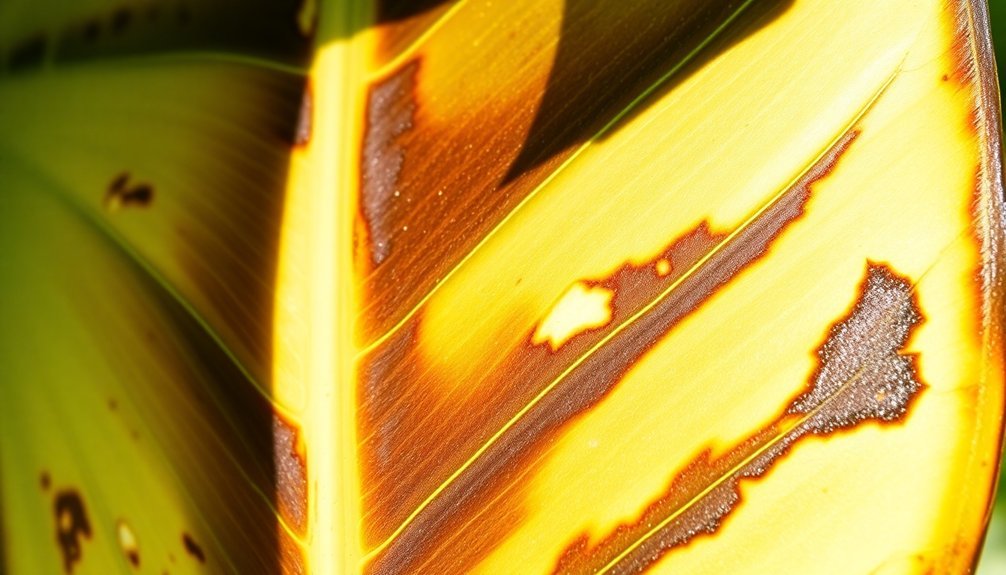
You'll notice distinct differences between mild and severe plant sunburn, with mild cases showing yellowing or browning at leaf tips and edges affecting less than half the leaf surface.
Severe sunburn appears as extensive browning across more than 50% of the leaf area, often requiring complete removal of the damaged foliage.
The earliest warning signs typically show up on top leaves within hours of excessive sun exposure, making it essential to monitor your plants during peak daylight hours.
Mild Vs Severe Burns
Just as human skin shows varying degrees of sunburn, houseplants display distinct symptoms based on their level of sun damage. When you notice mild sunburn, you'll see subtle yellowing or whitish patches appearing on the leaves, indicating your plant is experiencing initial light stress.
The difference between mild and severe burns is dramatic. While mild cases might only show slight discoloration, severe sunburn causes extensive damage. You'll spot brown or black patches spreading across the leaves, and they'll often become completely wilted.
In moderate cases, you'll notice a middle ground where leaves develop crispy brown tips while maintaining some green coloring. Since sunburn can progress quickly, sometimes within hours, it's essential to recognize these symptoms early and move your affected plants to a more suitable location.
Early Warning Signs
Early detection of plant sunburn can prevent lasting damage to your houseplants. The initial warning signs often appear quickly, sometimes within hours of excessive sun exposure.
You'll want to keep a close eye on your plant's upper leaves, as they're most vulnerable to sunburn damage.
- Leaves begin to show discoloration, turning yellow or white in patches where sun exposure is most intense.
- Leaf edges become crispy and start browning, especially if the exposure continues.
- Top leaves show more prominent symptoms while lower foliage may appear normal.
- Individual leaves develop scorched areas that won't recover their original color.
If you notice these signs, immediately move your plant to a shadier spot.
Key Differences Between Sunburn and Other Plant Issues
Since several plant problems can mimic sunburn damage, knowing the key differences is essential for proper diagnosis and treatment.
You'll notice sunburn appears primarily on leaves directly exposed to intense sunlight, showing yellow or white discoloration on the topmost foliage. Unlike overwatering issues, which cause widespread drooping and mushy stems, sunburn creates crispy, dry patches specifically on leaf edges and tips.
Time is another telling factor. Sunburn develops rapidly, often within hours of excessive sun exposure, while nutrient deficiencies and pest problems progress more slowly.
While other plant issues like fungal infections may create spotty patterns that can improve with treatment, sunburned leaves develop permanent brown, dead tissue that won't recover.
These distinct characteristics will help you accurately identify sunburn versus other common plant problems.
Most Vulnerable Indoor Plants to Sun Damage
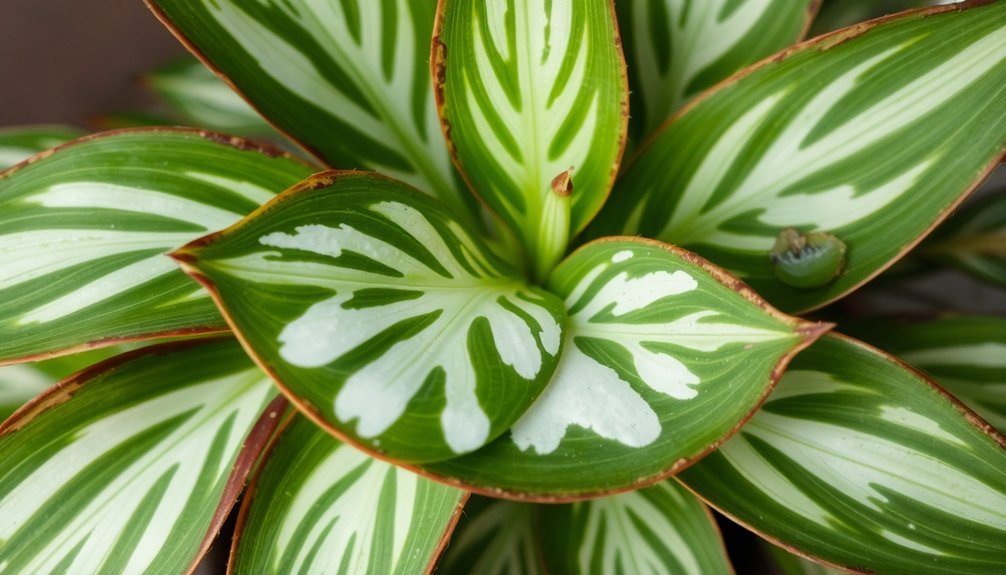
Indoor gardeners often discover that certain houseplants are especially prone to sun damage. The most vulnerable indoor plants to sun damage include peace lilies, ferns, and calatheas, which naturally thrive in low to moderate light conditions.
Even traditionally sun-loving plants like succulents and cacti aren't immune to sunburn when they're exposed to intense light too quickly.
Despite their desert origins, succulents and cacti can still suffer sunburn if not gradually acclimated to bright light conditions.
- Tropical houseplants like philodendrons and rubber plants show leaf discoloration and burning when placed in harsh, direct sunlight.
- Peace lilies and calatheas display browning edges and yellowing patches when overexposed.
- Snake plants and pothos develop bleached spots and crispy leaves from prolonged sun exposure.
- Ferns quickly develop dried, brittle fronds and lose their vibrant green color when sunburnt.
You'll need to monitor these sensitive plants carefully and provide appropriate indirect lighting to prevent damage.
Critical Areas to Check for Sunburn Damage
When checking your plants for sunburn damage, knowing exactly where to look can help you catch problems before they become severe.
Start by examining the top leaves, which receive the most direct sunlight and typically show the first signs of sunburn.
Watch for yellow or white patches developing on the leaves, particularly along their edges, which often turn dry and crispy in advanced cases.
While the upper foliage may show distress, don't forget to inspect the lower leaves as well. These bottom leaves usually remain healthy and can serve as a useful comparison to assess the extent of damage above.
You'll also want to look for any wilting throughout the plant, as this indicates it's struggling with too much sun exposure.
Visual Guide to Plant Sunburn Progression
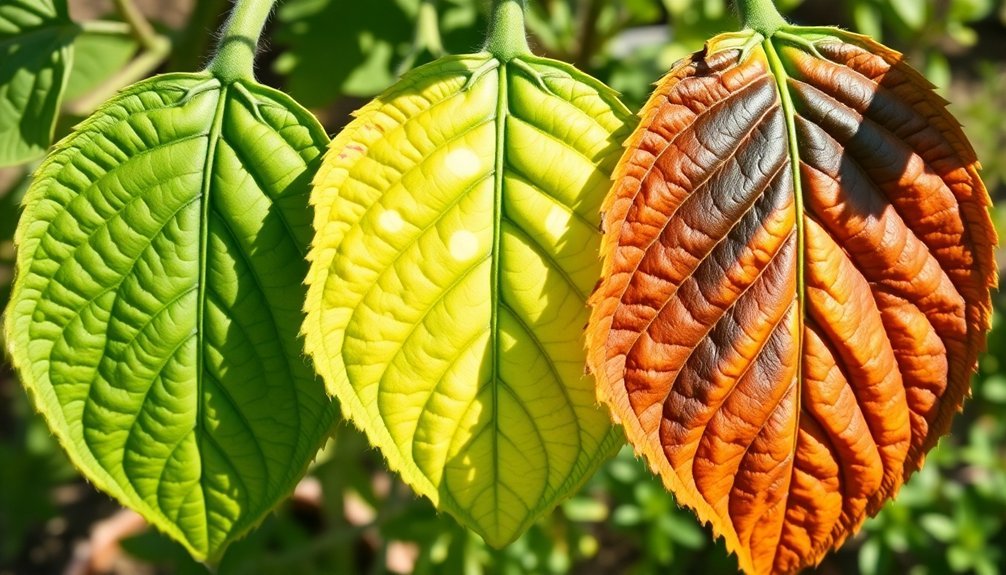
You'll notice the first signs of plant sunburn as yellow or white patches on upper leaves where direct sunlight hits the foliage.
As the damage worsens, these discolored areas turn brown, especially along leaf edges, and begin to shrivel within hours of excessive sun exposure.
While lower leaves often stay healthy due to natural shading, any severely burnt leaves won't recover their original color and should be removed to help your plant redirect its energy to healthy growth.
Early Sunburn Warning Signs
Spotting sunburn on your plants early can mean the difference between saving them and losing them to permanent damage.
When intense sunlight strikes your plants, symptoms can develop within just a few hours, making quick identification essential for their survival.
Watch for these telltale warning signs:
- Yellowing or whitening of top leaves, while lower foliage stays green due to natural shade protection
- Discoloration starting at the highest point of your plant, gradually moving downward
- Dry, crispy edges beginning to form on the most exposed leaves
- Bleached or faded patches appearing on leaf surfaces, indicating chlorophyll damage
Don't wait until you see brown, withered leaves to take action.
Regular monitoring of your plants, especially during peak sunlight hours, will help you catch and address sunburn symptoms before severe damage occurs.
Advanced Damage Indicators
As sunburn damage progresses beyond early warning signs, plants display increasingly severe visual indicators that can help you assess the extent of injury.
You'll notice the affected leaves turn distinctly yellow or white as the sun destroys their chlorophyll, while the edges become brown and crispy.
The most telling signs of advanced sunburn appear on your plant's upper foliage, where direct sunlight hits hardest.
Within just a few hours, you may see extensive damage develop, with up to 50% of individual leaves showing significant scorching.
While lower leaves often remain healthy due to natural shade protection, the top sections can wither and die if you don't take action.
When leaves reach this severe stage of damage, you'll need to remove them to maintain your plant's overall health.
Recovery Stage Features
Plants entering the recovery stage display distinct visual patterns that signal their healing process. You'll notice these recovery stage features as your plant begins healing from sunburn damage. The affected areas remain visible while new growth emerges from healthy sections.
- Dead leaf sections won't recover their original color – you'll need to remove these damaged portions to help your plant focus energy on new growth.
- Leaves with more than 50% sun damage will naturally drop off as the plant redirects resources.
- New leaf growth appears alongside yellowed or whitened areas, showing the plant's active recovery.
- Recovering plants develop a more resilient appearance as they adjust to their modified light exposure.
To prevent sunburn during recovery, gradually reintroduce your plant to sunlight while monitoring its response to the adjusted conditions.
Distinguishing Heat Stress From Light Damage
When your plants show signs of distress, it's crucial to determine whether they're suffering from heat stress or light damage, as each requires different treatment approaches. You'll notice sunburn appears as yellow or white patches on leaves exposed to direct sunlight, while heat stress causes overall wilting. The timing of symptoms also differs – sunburn damage shows up within hours, but heat stress develops more gradually.
| Feature | Sunburn | Heat Stress |
|---|---|---|
| Color | Yellow/white discoloration | No color change |
| Location | Top leaves only | Entire plant |
| Timing | Hours | Gradual onset |
| Leaf texture | Dry, brown edges | Soft, wilted |
| Treatment | Remove damaged leaves | Adjust watering/environment |
Recognizing Permanent vs. Temporary Sun Damage
Learning to distinguish between permanent and temporary sun damage helps you make essential decisions about plant care.
Permanent damage appears as brown, crispy patches that won't recover, while temporary sun damage shows up as yellowing or whitening that can heal if you act quickly.
- The highest leaves will show damage first, as they're directly exposed to harsh sunlight.
- Brown, crispy sections indicate permanent damage requiring removal.
- Yellow or white discoloration suggests temporary sun damage that's potentially reversible.
- Leaves with more than 50% scorching should be pruned to preserve plant energy.
You'll need to monitor your plant's response to light and make prompt adjustments.
When you notice signs of stress, relocating your plant to a more suitable spot can prevent temporary sun damage from becoming permanent.
Window Placement Effects on Plant Leaf Burns
Understanding your windows' orientation plays an essential role in preventing plant leaf burns. South-facing windows receive the most direct sunlight, making your plants more vulnerable to sunburn damage, which can show up as yellowed or brown leaves within hours of exposure.
You'll need to be strategic about protecting your plants from intense window light. If you notice early signs of leaf burn, try hanging sheer curtains or adjusting your blinds to diffuse the harsh rays.
Remember to check your plants regularly for any sunburn symptoms, especially during peak sunlight hours.
When you're moving plants closer to windows, introduce them gradually to the brighter conditions. This careful acclimation process helps your plants build tolerance to increased light exposure, reducing their risk of developing unsightly burns.
Seasonal Changes in Plant Sunburn Patterns
As the seasons shift throughout the year, your plants face varying levels of sunburn risk that require different protective measures. The amount of sun exposure changes dramatically, with spring and summer presenting the highest risk during peak hours between 10 AM and 4 PM.
You'll need to watch for seasonal changes in plant sunburn patterns, especially when relocating plants outdoors or when fall arrives and trees shed their leaves.
- Spring/Summer: Leaves show immediate browning or bleaching due to intense sunlight and longer days
- Fall: Previously shaded plants become exposed as tree canopies thin out
- Adjustment periods: Plants need gradual acclimation when moving to new light conditions
- Peak season: Most severe symptoms appear during summer's hottest hours, requiring extra protection
Remember that each plant species responds differently to seasonal light changes, so adjust their care accordingly.
Frequently Asked Questions
How to Tell if a Plant Is Sunburned?
You'll notice yellow or white patches on leaves, especially upper ones. Look for brown, crispy edges and tips. The damage appears quickly after sun exposure, while lower leaves often stay green and healthy.
Can Plants Recover From a Sunburn?
While your plant can't heal burned leaves, it can recover by growing new ones. You'll need to remove damaged foliage, relocate it to proper lighting, and be patient as it produces healthy new growth.
What Does Leaf Sunburn Look Like?
You'll notice yellow or white patches on your plant's leaves where direct sunlight has damaged them. In severe cases, you'll see brown, crispy edges and withered leaves, especially on the top parts of your plant.
What Does Sun Damage Look Like on Plants?
You'll notice your plants have sun damage when their leaves turn yellow or white, with brown, crispy edges. Look for withered spots, especially on top leaves that get direct sunlight exposure.
In Summary
Watch your plants carefully for signs of sunburn, and you'll soon recognize the telltale symptoms – from subtle bleaching to crispy brown patches. If you're seeing yellow or white spots, leaf curling, or dark scorched areas, it's time to adjust your plant's light exposure. Remember, prevention is easier than recovery, so don't wait until severe damage occurs to take action and protect your leafy friends.

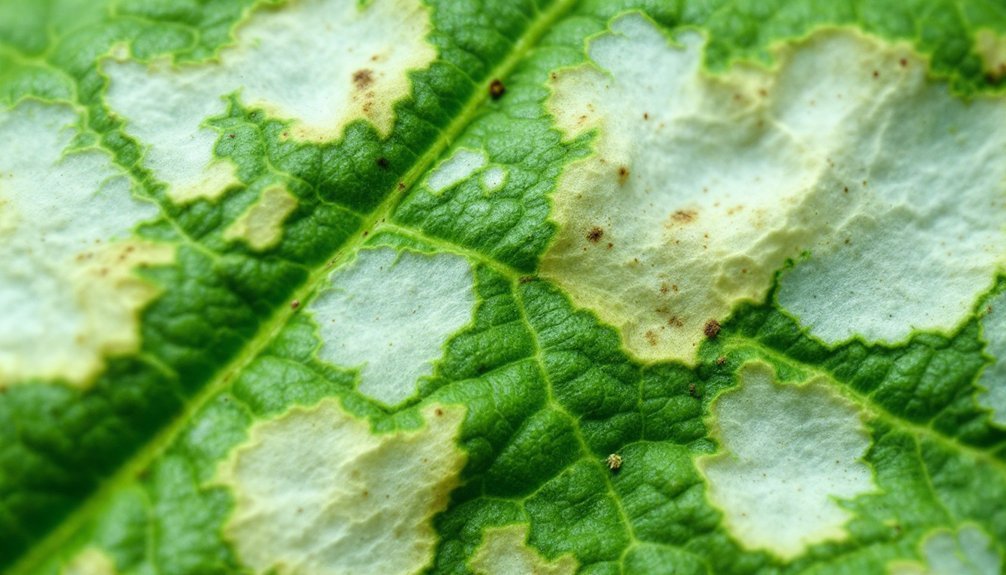



Leave a Reply